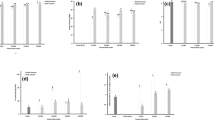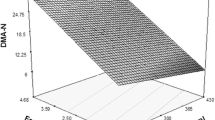Abstract
Pressure-shift freezing (PSF) is one of the most promising methods for obtaining high-quality frozen products. The aim of this work was to analyse the differences between broccoli that was frozen using two different PSF processes. In one of the processes, all the freezing was done inside the high-pressure vessel tempered at −20.5 °C. In the other process, the sample was taken out of the vessel after expansion, and freezing was completed using liquid N2. Colour, texture, electrical conductivity, microstructure and drip losses after centrifugation were analysed and a sensory test was performed. The results were compared with those for conventionally frozen broccoli purchased at the market. PSF broccoli presented less cell damage, lower drip losses and better texture than the market samples. The two different PSF processes assayed produced no significant differences in the final quality of the samples.








Similar content being viewed by others
References
Li B, Sun DW (2002) J Food Eng 54:175–182
Otero L, Sanz PD (2000) Biotechnol Prog 16:1030–1036
Kanda Y, Aoki M, Kosugi T (1992) Nippon Shokuhin Kogyo Gakkaishi 39:608–661
Fuchigami M, Teramoto A (1996) Texture and cryo-scanning electron micrographs of pressure shift frozen tofu. In: Hayashi R, Balny C (eds) High pressure bioscience and biotechnology, Elsevier Science, Amsterdam, pp 411–414
Fuchigami M, Teramoto A (1997) J Food Sci 62:828–832 and 837
Fuchigami M, Teramoto A, Ogawa N (1998) J Food Sci 63:1054–1057
Fuchigami M, Ogawa N, Teramoto A (2002) Innovat Food Sci Emerg Technol 3:139–147
Fuchigami M, Kato N, Teramoto A (1997) J Food Sci 62:804–808
Fuchigami M, Miyazaki K, Kato N, Teramoto A (1997) J Food Sci 62:809–812
Otero L, Solas MT, Sanz PD, de Elvira C, Carrasco JA (1998) Eur Food Res Technol 206:338–342
Otero L, Martino MN, Zaritzky N, Solas M, Sanz PD (2000) J Food Sci 65:466–470
Koch H, Seyderhelm I, Wille P, Kalichevsky MT, Knorr D (1996) Nahrung 40:125–131
Fuchigami M, Kato N, Teramoto A (1998) J Food Sci 63:122–125
Luscher C, Schlüter O, Knorr D (2005) Innovat Food Sci Emerg Technol 6:59–71
Otero L, Sanz PD (2006) J Food Eng 72:354–363
Chevalier D, Sequeira-Munoz A, Le Bail A, Simpson BK, Ghoul M (2000) Lebensm-Wiss u- Technol 33:570–577
Chevalier D, Sequeira-Munoz A, Le Bail A, Simpson BK, Ghoul M (2001) Innovat Food Sci Emerg Technol 1:193–201
Préstamo G, Palomares L, Sanz PD (2004) Eur Food Res Technol 219:598–604
Cover CM, Hsieh SJ, Tran SH, Hallden G, Kim GS, Bjeldanes LF, Firestone GL (1998) J Biol Chem 273:3838–3847
Faulkner K, Mithem R, Willianson G (1998) Carcinogenesis 19:605–609
Finley JW, Lisk DJ, Davis CD, Hintze KJ, Whanger PD (2001) J Agric Food Chem 49:2679–2683
Xu H, Orner GA, Bailey GS, Stoner GD, Horio DT, Dashwood RH (2001) Carcinogenesis 22:309–314
Houška M, Strohalm J, Kocurová K, Totušek J, Lefnerová D, Tríska J, Vrchotová N, Fiedleova V, Holasova M, Gabrovská D, Paulícková I. J Food Eng (in press)
Fernández PP, Otero L, Guignon B, Sanz PD (2006) Food Hydro 20:510–522
Acknowledgements
This research was carried out with financial support from the Spanish “Plan Nacional de I+D+i (2004-2006) MCYT” through the AGL 2003-06862-C02-00 project. P.P. Fernández thanks the CSIC of Spain for his grant in the context I3P program, supported by the European Social Fund. L. Otero was supported by a Ramón y Cajal research contract from the Ministerio de Educación y Ciencia in Spain.
Author information
Authors and Affiliations
Corresponding author
Rights and permissions
About this article
Cite this article
Fernández, P.P., Préstamo, G., Otero, L. et al. Assessment of cell damage in high-pressure-shift frozen broccoli: comparison with market samples. Eur Food Res Technol 224, 101–107 (2006). https://doi.org/10.1007/s00217-006-0294-0
Received:
Revised:
Accepted:
Published:
Issue Date:
DOI: https://doi.org/10.1007/s00217-006-0294-0




